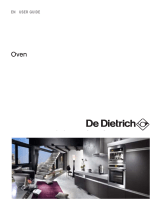Maintenance of accessories. Washable in
the dishwasher or by hand, using a little
detergent. Allow them to soak if they are
heavily soiled.
3.1
Smooth wall models. Clean the lukewarm
oven with a cloth soaked in hot soapy water.
3.2
Non-pyrolytic ovens
Pyrolytic ovens
Rough wall models. The oven has an enclo-
sure fitted with removable walls covered
with a special microporous enamel (catalytic
enamel) which gives them self-degreasing
properties.
Dirt is spread and diffused into the micropo-
res. It oxidises on to both surfaces and gra-
dually disappears. The self-degreasing
enamel is especially suitable for cooking
items containing fat, but when grilling, the
temperature of the walls is not always suffi-
cient to remove heavy fat splashes. In this
case, after cooking, continue to heat the
oven for 20 to 30 minutes at the maximum
temperature for the sequence chosen. If
there are traces remaining, they will reduce
during subsequent cooking.
Do not scrape the catalytic wall with a wire
brush, pointed or sharp implements.
3.3
Pyrolysis cleaning.
3.7
Pyrolysis : This type of cleaning takes
2 hours. Check that the display is showing the
time and is not flashing. To begin pyrolysis,
turn the function selector to (3.7.1). The
time for which the oven will not be available
is 2½ hours and cannot be adjusted (includes
cooling time). The door is locked during pyro-
lysis: a padlock or “Pyr” appears in the dis-
play (3.7.2). Cleaning ends automatically, the
display shows 0:00 and the door unlocks. Turn
the function selector back to 0.
Cleaning the inside of the oven:
To remove them, lift up the front part of the
shelf support to remove the hook from its
locating point (3.4.1). Then gently pull the
whole of the support towards you and lift the
back to release the rear hook from its loca-
ting point (3.4.2). Pull out the two shelf sup-
ports.
Wire shelf supports with hooks in the
centre.
For any cleaning operation inside the oven
cavity, the oven must be switched off. Before
carrying out any disassembly, allow the
appliance to cool and ensure that it is dis-
connected from the power.
Rough side walls. It is recommended that
you replace the two catalytic side walls when
their self-degreasing capability is no longer
effective. Start by removing the lateral wire
shelf supports (see previous section).
Remove the two old side walls and replace
them with new ones (3.5.1).
Back wall.
Before beginning a pyrolysis cleaning cycle in
your oven, remove all parts of your grids, trays
and accessories and remove major spill resi-
due. If your oven has enamelled wire shelves,
it is not necessary to remove them.
During cleaning, the surfaces may become
warmer than under normal conditions of use. It
is advisable to keep small children away from
the appliance.
Pyrolysis is a cycle where the oven is heated
to a very high temperature which removes
all dirt due to splashes and spills. The fumes
and odours release are destroyed by passing
through a catalytic converter.
However, pyrolysis is not necessary after every
cooking operation but only when the level of
soiling requires.
As a safety measure, cleaning only occurs after
the door locks automatically. When the tempe-
rature inside the oven exceeds cooking tempe-
ratures, it is impossible to open the door.
3.5
3.6
3.4
Cleaning the door.
3.8
Do not use abrasive cleaning products or
hard metal scrapers for cleaning the oven's
glass door, as they could scratch the sur-
face and cause the glass to shatter.
Before unclipping the glass, allow the
appliance to cool.
Before removing the back wall, the
appliance must be powered off.
Completely unscrew the two screws at the top
of the back wall. Tilt the wall forward and
remove it from the cavity (3.6.1).
After cleaning, the back wall must be put back
in place in accordance with the instructions.
Maintenance
and cleaning








